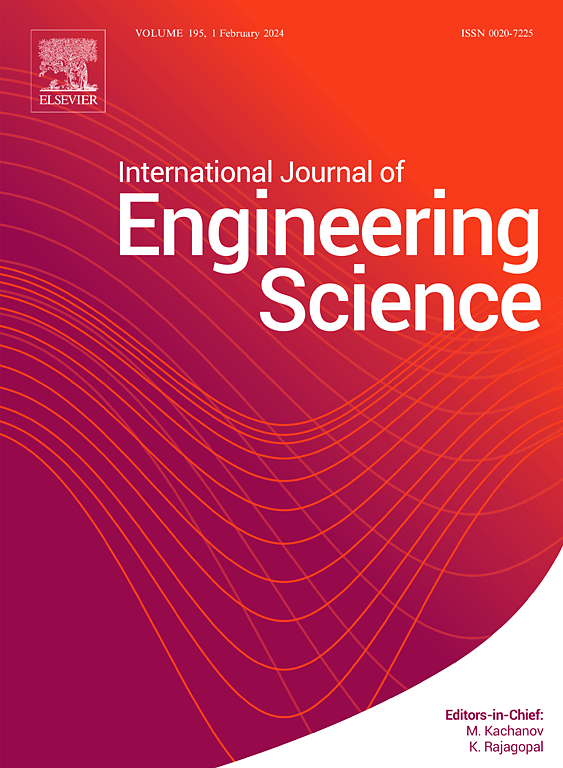表面应力对静电和分子间力作用下纳米反杠杆拉入不稳定性的影响
IF 5.7
1区 工程技术
Q1 ENGINEERING, MULTIDISCIPLINARY
International Journal of Engineering Science
Pub Date : 2025-08-15
DOI:10.1016/j.ijengsci.2025.104356
引用次数: 0
摘要
考虑了表面残余应力和表面引力的影响,研究了静电驱动纳米反杆的拉入失稳问题。利用纳米反杆的格林函数,用等效的挠度积分方程代替原来的微分方程,提出了一种新的方法。此外,综合侧向力由包含两个未知参数的轴坐标幂函数近似表示,即幂律指数和尖端挠度。这两个未知数可以从匹配过程中找到,要求在考虑近似荷载分布时,计算在跨中和自由尖端的侧向力的近似分布必须与由控制积分方程预测的挠度计算出的实际荷载分布相吻合。用这种方法,导出了两个未知参数作为外加电压函数的非线性代数方程组。然后,静电电压达到的最大值提供了拉入电压和拉入偏转的近似值。绘制的结果显示了正、负残余表面应力和表面吸引力对拉入参数的影响。还考虑了一种由硅制成的纳米反杠杆的实际应用,该纳米反杠杆的表面具有晶体学方向[100]。可以观察到,对于非常薄的Si[100]纳米反杆,在没有施加任何静电电压的情况下存在一个临界长度,并且在活动电极和固定电极之间存在任何间隙距离。本文章由计算机程序翻译,如有差异,请以英文原文为准。
Effect of surface stresses on pull-in instability of a nanocantilever under electrostatic and intermolecular forces
The problem of pull-in instability of an electrostatically actuated nanocantilever is investigated here by considering the effect of the residual surface stress and surface attractions. A novel approach is developed by replacing the original differential equation with an equivalent integral equation for the deflection, obtained by using the Green’s function of the nanocantilever. Moreover, the resultant lateral force is approximated by a power function of the axial coordinate containing two unknown parameters, namely the power-law exponent and the tip deflection. These two unknowns can be found from a matching procedure by requiring that the approximated distribution of the lateral force calculated at the midspan and at the free tip must coincide with the actual load distribution calculated from the deflection predicted by the governing integral equation when the approximated load distribution is considered. In this way, a system of two nonlinear algebraic equations for the two unknown parameters as functions of the applied voltage is derived. The maximum attained by the electrostatic voltage then provides the approximated values of the pull-in voltage and the pull-in deflection. The plotted results show the effects of positive and negative residual surface stress and surface attractions on the pull-in parameters. A practical application is also considered for a nanocantilever made of Silicon with crystallographic direction [100] on faces. It is observed that for a very thin Si[100] nanocantilever there exists a critical length at which the nanobeam buckles without any applied electrostatic voltage and for any gap distance between movable and fixed electrodes.
求助全文
通过发布文献求助,成功后即可免费获取论文全文。
去求助
来源期刊

International Journal of Engineering Science
工程技术-工程:综合
CiteScore
11.80
自引率
16.70%
发文量
86
审稿时长
45 days
期刊介绍:
The International Journal of Engineering Science is not limited to a specific aspect of science and engineering but is instead devoted to a wide range of subfields in the engineering sciences. While it encourages a broad spectrum of contribution in the engineering sciences, its core interest lies in issues concerning material modeling and response. Articles of interdisciplinary nature are particularly welcome.
The primary goal of the new editors is to maintain high quality of publications. There will be a commitment to expediting the time taken for the publication of the papers. The articles that are sent for reviews will have names of the authors deleted with a view towards enhancing the objectivity and fairness of the review process.
Articles that are devoted to the purely mathematical aspects without a discussion of the physical implications of the results or the consideration of specific examples are discouraged. Articles concerning material science should not be limited merely to a description and recording of observations but should contain theoretical or quantitative discussion of the results.
 求助内容:
求助内容: 应助结果提醒方式:
应助结果提醒方式:


